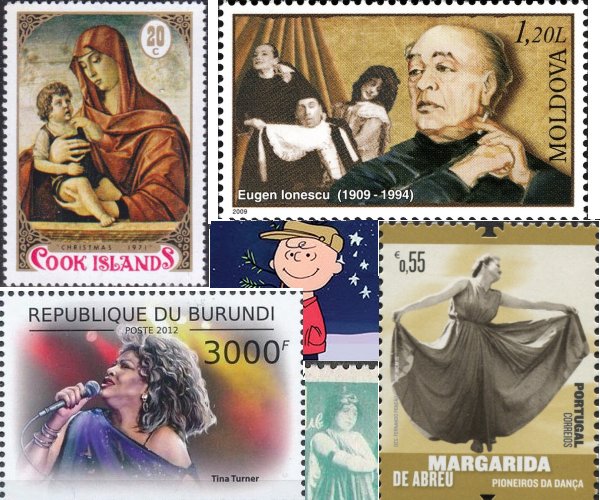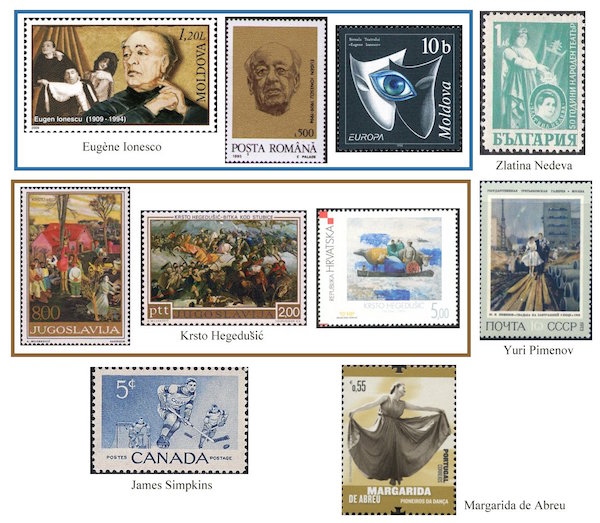The Arts on Stamps of the World — November 26
An Arts Fuse regular feature: the arts on stamps of the world.

By Doug Briscoe
Today we salute Giovanni Bellini, who died 501 years ago today, and Eugène Ionesco, who was born on this day 108 years ago. It’s also the birthday of Peanuts creator Charles Schulz and eleven-time Grammy winner Tina Turner.
Giovanni Bellini (c1430 – 26 November 1516) is probably the best known painter of his family, which also included his father Jacopo and his brother Gentile. Moreover, his brother-in-law was Andrea Mantegna. Gentile, with whom he lived and worked closely, was the more respected in their lifetimes, but posterity seems to have awarded Giovanni the greater reputation. Born in Venice, he was named conservator of the paintings in the Doge’s Palace around 1479. His students included Giorgione and Titian. The vast majority of Bellini’s output was religious in nature, with a particularly large number of madonnas. A full set of five of these, all different, was issued by the Cook Islands for the Christmas season of 1971, and from the set we see the Alzano Madonna (c1485), two more examples of c1470 and 1510, and the central details from Sacra conversazione giovannelli (1500-04) and the piece for the sacristy of Santa Maria Gloriosa dei Frari (1488), which also appears in monochrome on a Costa Rican stamp. In the next row we offer, on a stamp from Palau, a detail from the San Zaccaria Altarpiece (1505); The Agony in the Garden of Gethsemane (c1465); the Presentation at the Temple (c1459?), a Pietà (c1460), and the Pesaro Altarpiece (aka, The Dead Christ Mourned, 1474). The large sheet at bottom center offers Sacred Allegory (c1490-99). On either side of it are two of Bellini’s secular pieces, The Feast of the Gods (c1514, completed by Titian in 1529) and Young Woman at Her Toilette (1515).
The inimitable Romanian-French playwright Eugène Ionesco (November 1909 – 28 March 1994) appears on stamps of Moldova and Romania, with, at right, one celebrating the Ionesco Biennial Theater Festival, again from Moldova. I’m frankly surprised there isn’t one from France, given that he lived so much of his life there and was admitted to the Académie française in 1970.

While we’re in the theater, let’s give a nod to Bulgarian actress Zlatina Nedeva (November 26, 1878 –May 21, 1941), in all probability the country’s first female theater director. She studied theater arts in Zagreb and became an actor at the Bulgarian National Theater in 1904. Later accomplishments included the founding of a chamber theater in 1921 and its direction until 1924 and the direction of two more theaters in the mid-1930s.
It happens that the Croatian artist Krsto Hegedušić (heg-eh-DOO-shitch; 26 November 1901 – 7 April 1975) also studied his craft in Zagreb, enrolling in the city’s Arts and Crafts College in 1920. He held his first one-man show in Zagreb in 1926. On a scholarship from the government of France Hegedušić studied in Paris in the years 1926-28, making a particular study of the paintings of Pieter Brueghel. In his own work his favorite themes were of a social nature, depicting typically the exploitation of the peasant class. Not surprisingly, he co-founded and unofficially headed a pro-Marxist artist’s group called Zemlja (“Soil”) in 1929. The next year he established a school promulgating the naive (or primitivist) art movement. After having been arrested several times he kept a low profile during the war, but immediately afterward was rewarded with a professorship at the Zagreb Academy. He created some surrealist pieces at this time and founded a master’s studio in 1950. Hegedušić also worked as a book illustrator and theater designer. Three stamps showing his work have been issued, two from Yugoslavia, one from Croatia. These are Justice (or The Hanging, 1934), the Battle of Stubica (1973), and on the more recent Croatian stamp, On the Drava River (1960).

We remain in Eastern Europe for Soviet artist Yuri Pimenov ( November 26 [O.S. 13], 1903 –September 6, 1977) from Moscow. He worked as an illustrator for magazines at the age of 20 but soon branched out into painting, posters, theater and set design, and graphic art. His earlier pieces reflect the influence of German expressionism, later his work was more reflective of impressionism (nowhere more clearly evident than in Paper Flowers and Snow (1945), but all in all he never strayed too far from Socialist Realism (cf. Construction Worker). The piece on the 1973 stamp, Wedding on a Future Street (1962), has to my eye more of the look of a magazine illustration to it.
And speaking of lighter illustration, we turn to Canadian cartoonist James Simpkins (November 26, 1910 – February 1, 2004), born in Winnipeg. He worked for the National Film Board and then as a freelancer. He created the character of Jasper the Bear in 1948 as the mascot for Jasper National Park. We don’t have Jasper on a stamp, but we do have Simpkins’s design for a 1956 stamp saluting Canadian hockey.
Margarida de Abreu (1915 – 29 September 2006) studied dance in Geneva, Berlin, and Vienna and the teaching of dance in Sadler’s Wells. For nearly fifty years she taught at the Portuguese National Conservatory. She founded the Círculo de Inicição Coreográfica (Choreographic Initiation Circle, CIC) in 1946 and is thought of as a seminal figure in Portuguese classical ballet. The stamp was issued two years ago as part of a group of six stamps honoring Portuguese ballet dancers.

Charles M. Schulz (November 26, 1922 – February 12, 2000) was, as everybody knows, the creator of the beloved comic strip Peanuts. Born an only child in Minneapolis, he displayed his gift for drawing from childhood. After service in World War II (he saw very little action and related that on the one occasion he had to fire his.50 caliber machine gun he found he had forgotten to load it), Schulz worked for Art Instruction, Inc., an outfit from which he had once taken a correspondence course. His first cartoons appeared as Li’l Folks from 1947 to 1950 in the St. Paul Pioneer Press. Peanuts came before the world on October 2, 1950, in seven newspapers. Wikipedia provides the factoids in, you should pardon the pun, a nutshell: “At its height, Peanuts was published daily in 2,600 papers in 75 countries, in 21 languages. Over the nearly 50 years that Peanuts was published, Schulz drew nearly 18,000 strips. During the life of the strip, Schulz took only one vacation, a five-week break in late 1997 to celebrate his 75th birthday; reruns of the strip ran during his vacation, the only time reruns occurred while Schulz was alive.” I was surprised and pleased to learn that Schulz had been a lover of classical music from young adulthood, his favorite composer, they say, being Brahms. The first Peanuts stamp, Snoopy hunting his nemesis the Red Baron, came out in 2001, the year after Schulz’s death. Just two years ago the USPS issued a full booklet of Charlie Brown Christmas stamps. Gibraltar issued Peanuts Christmas sheets in 2001 and 2003.
One of the most popular recording artists ever, Tina Turner (born November 26, 1939) started out with future husband Ike Turner’s Kings of Rhythm in 1958. At that time she went by the name “Little Ann” (her birth name was Anna Mae Bullock); she adopted the stage name Tina Turner in 1960. Again according to Wikipedia, the singer has “sold more concert tickets than any other solo performer in history.” Sales of albums and singles have reached 180 million copies. Tina Turner gave up her American citizenship in 2013, as she has had a primary residence in Switzerland since 1994.
English poet William Cowper (26 November 1731 – 25 April 1800) surely deserves a stamp, if only for “GOD moves in a mysterious way, / His wonders to perform,” and for one of my own dearest precepts: “Variety’s the very spice of life.” I loved the superb Irish actor Cyril Cusack (26 November 1910 – 7 October 1993). One of his six children, actress Sinéad Cusack, married Jeremy Irons in 1978.
A graduate of the University of Massachusetts with a B.A. in English, Doug Briscoe worked in Boston classical music radio, at WCRB, WGBH, and WBUR, for about 25 years, beginning in 1977. He has the curious distinction of having succeeded Robert J. Lurtsema twice, first as host of WGBH’s weekday morning classical music program in 1993, then as host of the weekend program when Robert J.’s health failed in 2000. Doug also wrote liner notes for several of the late Gunther Schuller’s GM Recordings releases as well as program notes for the Boston Classical Orchestra. For the past few years he’s been posting a Facebook “blog” of classical music on stamps of the world, which has now been expanded to encompass all the arts for The Arts Fuse.
